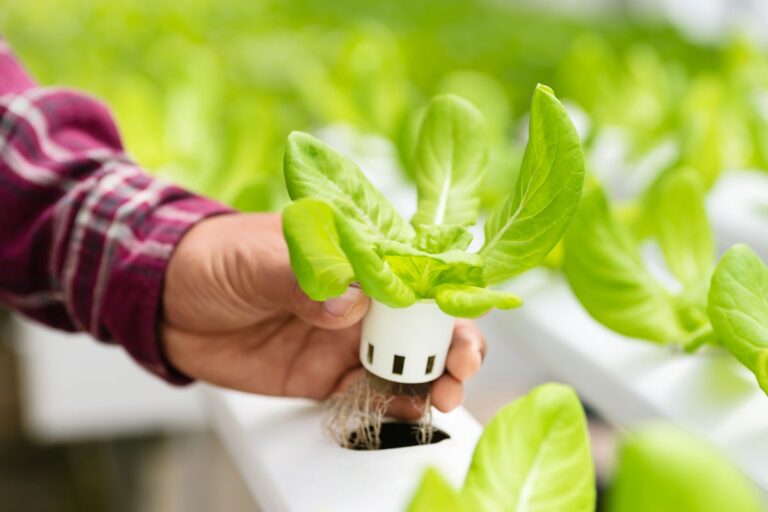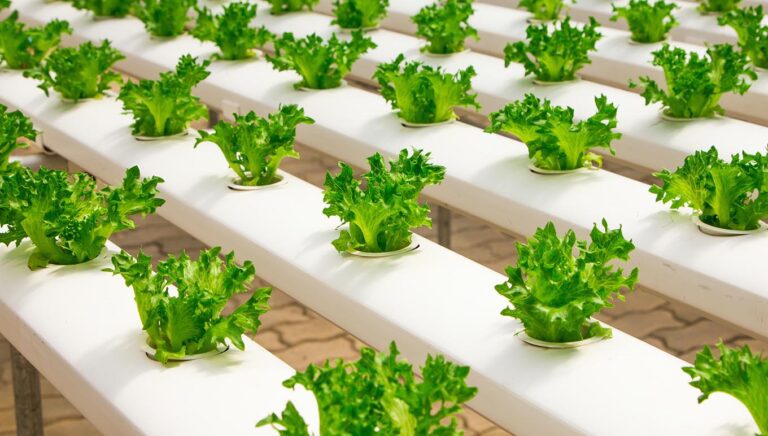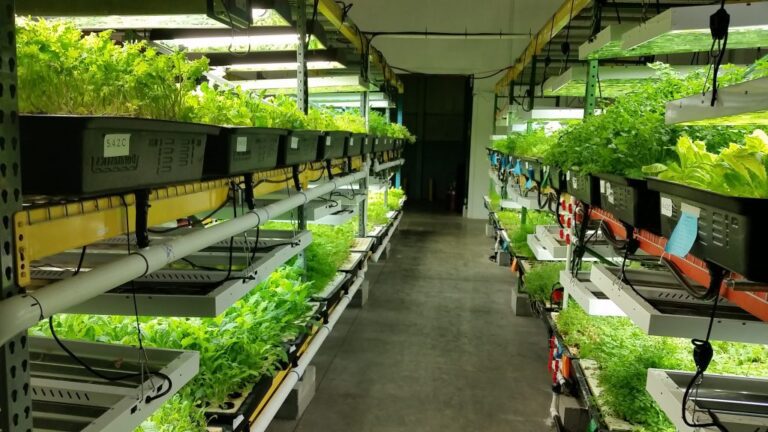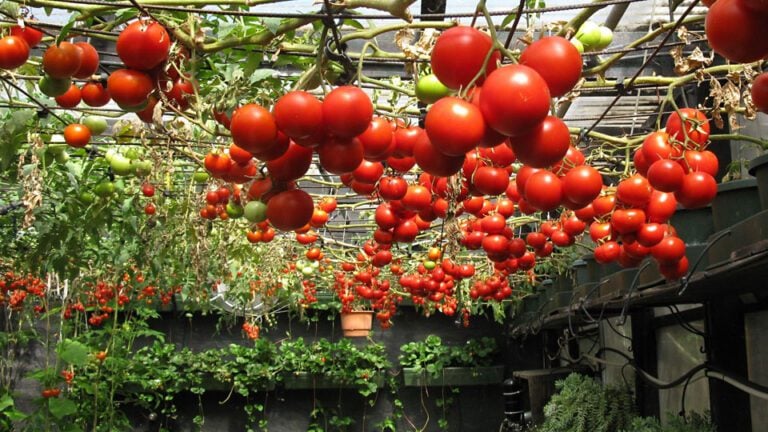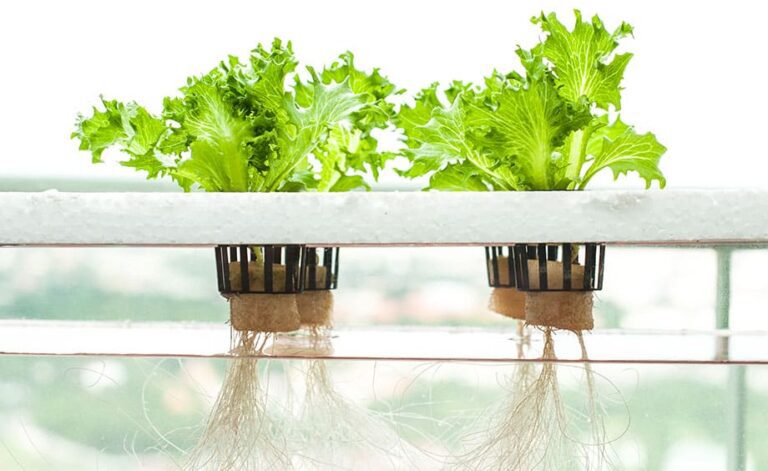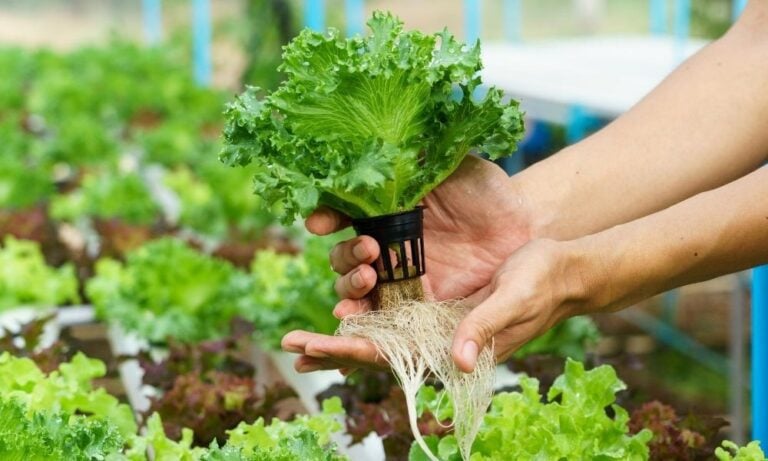9 Efficient Hydroponics Designs
Before we get to the different hydroponics designs, let’s clarify what hydroponics is.
Hydroponics Definition:
Hydroponics is an increasingly standard method of growing plants that uses a nutrient-rich mix with a water base. This means that soil or dirt isn’t used in a hydroponics method. Instead, the plant roots are maintained by substances such as Rockwool, peat moss, clay pellets, and perlite.
Hydroponics is an efficient method for growing plants by placing plants in a nutrient-rich water mixture. Instead of using soil or earth to grow the plants, the plant roots come into direct contact with the nutrient-rich blend. The plants also have access to a considerable amount of oxygen, which helps to assist growth. The primary benefit of using hydroponics to produce plants is that it makes for a much quicker growth rate.
When you’re searching to use or create a hydroponic system to grow plants, there are numerous variations of hydroponic systems that you can use — only six main types of hydroponic systems in which all variations are positioned.
Essential Parts of Hydroponics:
Hydroponic systems can be either passive or active. Active means nutrient mixtures will be moved around, usually by a drain or a pump. Passive relies on the anchor or a wick of the growing method. Hydroponic systems are also categorized as recovery or non-recovery. Recovery refers to the method by which the nutrient solution will be recycled into the system. While with non-recovery, the nutrient mixture is applied to the growing plants and then vanishes.
There are six primary types of hydroponic systems. The plant roots only need three things, oxygen, water or moisture, and nutrients.
So, what differs between the six methods is the system’s technique to deliver these three vital things to the plant roots. Of course, there are many variants with various names, but they all simmer down to these six core types of Hydroponic systems.
Types of hydroponic systems:
We will discuss six main types of hydroponic systems in this article.
1. Wick System
The wick system is the simplest type of hydroponic method that you can use to develop plants, which means that practically anyone can utilize it. You won’t need extensive knowledge or skills to make it work properly. The wick system is noted for not using electricity, aerators, or pumps. Moreover, it’s the only hydroponic system that doesn’t require electricity. Most wick systems include placing the plants directly within a porous substance like vermiculite or perlite. Nylon wicks are arranged around the plants before they are sent into the nutrient mix.
If you’re contemplating using a wick hydroponic system to grow your plants, you need to know that the simple nature of this system indicates that the plants cannot obtain a substantial amount of nutrients. As such, the system is idyllic for herbs and small and garden plants. Plants that don’t require ample water will produce well in this specific system.
Although this system is fantastic for smaller plants, you’ll have to avoid growing plants like tomatoes and peppers. They are considered heavy-feeding plants, requiring more nutrients than the wick system can deliver.
Another negative feature of this growing system is that nutrients and water aren’t absorbed evenly, which can lead to the buildup of deadly mineral salts. If you use this system, ensure that you drain any extra nutrients with fresh water every couple of weeks.
2. Water Culture:
A water culture method is another extremely simplistic hydroponic system that positions the plant’s roots directly into the nutrient mixture.
Although the wick system places particular materials between the water and the plants, the water culture system avoids this barrier. The oxygen the plants require to survive is sent into the liquids by an air stone or a diffuser. If you use this system, remember that the plants should be appropriately positioned with net vessels.
The best feature of this system is that the roots are positioned directly into the nutrient mixture, so the plants readily absorb the nutrients. Because of the direct access to oxygen and nutrients, plants grown by the water culture method will develop rapidly. Another benefit of the water culture system is that it’s effortless to create and works well with any plant. Even large plants with extensive foot systems will grow fast with this method.
The only potential problem with the water culture system is the occurrence of root diseases caused by dirty growing situations.
3. Ebb and Flow (Flood and Drain):
The Flood and Drain system is another standard hydroponic system that home gardeners mostly use. With this system, the plants are placed in a large grow bed filled with a medium like perlite or Rockwool. Once the plants are carefully embedded, the grow bed is submerged with a nutrient-rich mixture until the water reaches a couple of inches underneath the growing medium’s top layer, ensuring that the nutrient mix doesn’t flood.
The water pump that overflows the grow bed is prepared with a timer that switches the pump off after a specified time. When this happens, the excess water will be drained from the grow bed and directed back into the pump. This system has been efficient for growing nearly all kinds of plants, including certain root vegetables like radishes and carrots.
However, we suggest you don’t use huge plants with an ebb and flow system. Because of how much area the plants will need, you might be unable to fit enough of the nutrient solution and grow medium into the bed with larger plants. The critical issue with the ebb and flow hydroponic system is that the pump control can fail, which can halt operation until the pump is replaced or fixed.
4. Drip Systems:
A drip system is another easy-to-use hydroponic arrangement that you can quickly tailor for different types of plants, which makes it great for any gardener or farmer who plans to make regular alterations. The nutrient solution utilized with a drip system is propelled into a tube that sends the solution directly to the plant base. At the end of each pipe is a drip emitter that controls the amount of solution to be placed in the plant. You can regulate the flow to meet the requirements of each plant.
These systems can be as large or small as you want. They can also be non-circulating or circulating systems. A circulating system will trickle almost continuously. Any excess nutrients will be returned to the tank that stores the nutrient solution. Since you can freely alter the flow rate and size of this hydroponic system, it can be operated to grow nearly any plant you want.
If you choose to use a circulating system, the main issue you’ll encounter is that you’ll need to constantly maintain the fluctuating pH and nutrient levels that occur when the mixture is recirculated.
5. Nutrient Film Technology – N.F.T.:
The N.F.T. system has a straightforward design but is mainly used because of how well it balances a variety of specific applications. The nutrient mix is placed into a large tank when you use the N.F.T. system. From here, the solution is sent by a pump into sloped canals that allow the extra nutrients to flow back into the tank. When the nutrient solution is pumped into the outlet, it flows down the incline and over the plants’ roots to provide the correct amount of nutrients.
We highly recommend that you use net containers with this type of hydroponic N.F.T. system. In many cases, the N.F.T. system won’t need a growing channel. Since the mediums used with this system are moderately small, we suggest you pair them with plants with lesser roots.
Although this system can’t graciously accommodate larger plants, it scales well, meaning you can tailor it to allow for the development of a large number of plants simultaneously. Since it balances well, home growers and commercial farmers commonly use the N.F.T. system.
6. Aeroponic Systems:
Aeroponic systems are easy to understand but somewhat challenging to construct. With this kind of system, the plants you want to grow will be hung in the air. A couple of vapor nozzles are placed below the plants. These nozzles spray the nutrient mix onto the roots of the plants, which has been recognized as a very effective and efficient hydroponic method. The mist nozzles are directly connected to the water pump. When the pressure rises in the pump, the mixture is sprayed, with the excess falling into the basin below.
As long as you use the correct measurements for the reservoir, you can produce and cultivate nearly all types of plants by using this aeroponic system. However, the tank needs to be exceptionally deep if you plan to grow larger plants. Otherwise, the mist nozzles might not be able to reach all of the roots. Since plants with such a system are hung in the air, they get all the oxygen required.
This system also uses less water than the other hydroponic systems, which is excellent for efficacy. However, there are a couple of problems with this system. They can be expensive to build. The nozzles that shower the nutrients onto the roots of the plants can also become clogged, which can be annoying to clean.
Variations of the Primary Hydroponic Systems:
All other hydroponic systems are variations of those mentioned above six central systems. You may have seen these systems but don’t know their names or where they come from. Let’s have a look at these variations:
1. The Kratky Method
The plants are placed in a net container hung by a hanging platform. Parts of the roots are immersed in the water while the rest are bared to the air. As the plants grow, the water level decreases with time, leaving an air region for the plant roots. It is a detached system.
Pros:
Very easy to set up.
Little effort is needed.
Inexpensive.
Cons:
Only efficient for plants that grow fast, like spinach or lettuce.
Not suitable for large plants.
The Kratky method is a variant of the Water Culture system. The difference is that the Kratky does not need electricity to run. So no pump or timer is used.
The Kratky method is straightforward. Fill a reservoir or container with water and nutrients and cover it with a lid. Cut the lid to place a net pot. Place the plants in the net pot with a growing medium so that their roots are hung by the cover. They must be partly exposed to the air while parts of the roots are sunk into the water. The plants can take up sufficient nutrients, oxygen, and water and grow with time. When the container runs out of water, your plants have grown into adults. If such is not the case, you can refill the reservoir with nutrient solution and water and allow the plants to continue their growth.
The Kratky requires slight care and maintenance. It is also not costly. That makes it one of the most straightforward systems to set up, suitable for hobbyists, starters, and even children.
2. Fogponics
Fogponics is an aeroponics variation. A fogger, connected to a timer, is used to transform the nutrients and water from the container into extremely tiny droplets of fog or vapor. Plant roots are suspended freely in the air with sufficient access to oxygen. They get nutrients and moisture through the wet atmosphere due to the fog.
Pros:
Thorough exposure to the roots.
Water saving due to recirculating.
Cons:
Built-up salt.
Vulnerable to power outages.
Expensive.
3. Dutch Bucket
Dutch Bucket System is an Ebb & Flow variation. Several containers are placed on the floor or a bench. Each bucket must contain one plant. An enormous reservoir or basin holds the nutrient mixture, pumped through the irrigation lines, and dropped onto the plants through emitters. The excess nutrient and water solution can return to the tank through the drain line or is drained out of the system.
Pros:
Great for diverse plants, including vining, fruiting, and bushy ones.
Flexible.
Good for beginners.
Cons:
Require maintenance.
Prone to power outages.
Diseases might spread fast if they strike the reservoir.

